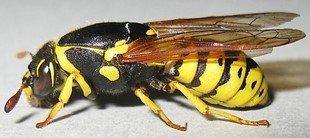Tropical and subtropical wasps.
Affiliation

Co-authors: Marcus Vinícius de Oliveira Santana1 and Klebert de Paula Malheiros2.
*Instituto Marcus Vinícius de Oliveira Santana1-2. Goiânia, Goiás, Brazil.
1. The pot wasp
The wasps of the subfamily Eumeninae or eumeninos are known because some of the species within this subfamily build their nests using clay in the shape of a pot or pot. An example of the pot wasp is Zeta argillaceum (Linnaeus, 1758), which also uses cavities in soil, wood, or abandoned nests. Within this subfamily, there are almost 200 distinct genera of wasps, most of which are solitary and some have primitive social characteristics. This type of wasp can be dark, black, or brown and with patterns that contrast the background color, such as yellow or orange (Figure 1) [1-5].

Figure 1. It took this potter wasp - Eumenes fraternus Say 1824 - just over 1 hour to make this pot. Sources: Project Noah, Spotted by Anjay Krishna and http://www.projectnoah.org/spottings/969776003— in India.
They are animals that can fold their wings longitudinally, like most wasps. They feed on caterpillars or beetle larvae. They also consume nectar, which gives them energy to fly. The wasp can be dark, black, or brown and with patterns that contrast with the background color, such as yellow or orange. [1-5].
2. The pollen wasp
Among the different types of wasps, those from the subfamily Masarinae or masarineos are insects that feed exclusively on pollen and nectar from flowers. This behavior is more similar to that of bees, since in most wasps carnivorous behavior is a common denominator. In this subfamily are the genera Gayellini and Masarini. These types of wasps are dark in color with contrasting light tones that can be red, white, and yellow, among others. They have club-shaped antennae and live in mud nests or burrows made in the ground. They can be found in South Africa, North America, and South America in desert regions. (Figure 2).

Figure 2. Pollen Wasp - Pseudomasaris vespoides (Cresson, 1863) - Female Clear Cut area 1 mile Nort. Clear Cut area 1 mile North of Westwood, Lassen County, California, USA. Sources: Photo#1335190 and https://bugguide.net/node/view/1335190.
The polistinos or Polistinae wasps are a subfamily of the wasps, where we can find a total of 5 different genera. There are the genera Polistes Latreille, 1802, Mischocyttarus Saussure, 1853, Polybia Lepeletier, 1836, Brachygastra Party, 1833, and Ropalidia Guérin-Méneville, 1831. They are wasps that live in tropical and subtropical climates, in addition to being eusocial. They have a narrow abdomen, with curved antennae in the case of males. The queen females are similar to the workers, something rare since in general, the queen of a colony is much larger. The genera Polybia, and Brachygastra have the peculiarity of producing honey [5-8].
3. The vespines
These wasps, also known as Vespinae wasps, are a subfamily that has 4 genera, speak of Dolichovespula Rohwer, 1916, Provespa Ashmead, 1903, Vespa Linnaeus, 1758, and Vespula Thomson, 1869. Some of these species live in colonies, others are parasitic and lay their eggs in the nests of other insects. They are wasps that have a more developed sense of socialization than the Polistinae. The nests are of a type of paper, formed by chewed wood fiber, and make their nests in trees and under the ground. We can find them on all continents of the world, except Antarctica (Figure 3).

Figure 3.Vespula austriaca (Panzer,1799). Sources: Photo (C) Josef Dvorak www.biolib.cz for BWARS and https://bwars.com/wasp/vespidae/vespinae/vespula-austriaca.
They feed on insects and, in some cases, the flesh of dead animals. Some species invade the nests of other species, killing the queen of the colony and forcing the worker wasps to take care of the invading young. They can invade nests of the same species or nests of species with which they are related. In the genus, Vespa are wasps that are colloquially called hornets because they are more robust than traditional wasps [9-12].
References
[1] van Noort S. WaspWeb [Internet]. Cape Town: Hymenoptera of the Afrotropical region; @ 2023 [cited 2024 Mar 06]. Available from http://www.waspweb.org.
[2] Alves-dos-Santos I, Machado IC, Gaglianone MC. Natural history of oil-collecting bees. Oecologia Brasiliensis. 2007; 11(4): 544-557.
[3] Michener CD. The bees of the world. 1st ed. Baltimore & London: Johns Hopkins Univ. Press. 2000.
[4] Reis MG, Faria AD, Bittrich V, Amaral MCE, Marsaioli AJ. The chemistry of flower rewards Oncidium (Orchidaceae). Journal of the Brazilian Chemical Society. 2000; 11: 600-608.
[5] Sazima M, Sazima I. Oil-gathering bees visit flowers of glandular morphs of the oil-producing Malpighiaceae. Botanica Acta. 1989; 102: 106-111.
[6] Silveira FA, Melo GAR, Almeida EAB. Brazilian bees - Identification and Systematics. 1st ed: Belo Horizonte. Author's edition. 2000.
[7] Steiner KE, Whitehead VB. Oil flowers and oil bees: Further evidence for pollinator adaptation. Evolution. 1991; 45: 1493-1501.
[8] Santos AI. Nesting in oil-collecting bees [Internet]. Maranhão: Meeting on bees; @ 2006 [cited 2024 Mar 05]. Available from https://www.uema.br/2014/10/uema-realiza-vii-encontro-sobre-abelhas-nativas-no-maranho/.
[9] Santos AI. Bees of the Brazilian Savanna. 1st ed. Oxford: Eolss Publishers. 2007.
[10] Vogel S, Michener CD. Long bee legs and oilproducing floral spurs, and a new Rediviva (Hym., Melittidae; Scrophulariaceae). Journal of the Kansas Entomological Society. 1985; 58: 359-364.
[11] List of Italian Melittidae. Italian Entomologists Forum [Internet]. Rome: Italian Entomology; @ 2023 [cited 2023 May 06]. Available from http://www.entomologiitaliani.net/public/forum/phpBB3/.
[12] Tomozii B. Bees of Romania [Internet]. Bacaú: Family Metillidae; @ 2010 [cited 2024 Mar 06]. Available from https://www.beesofromania.ro/home.
Open Peer Review
